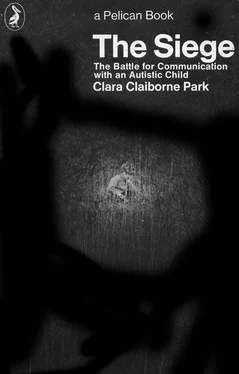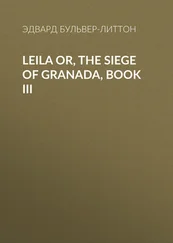Hesitation, caution, unwillingness to interact with the physical world. These sound like the shapes of fear, and perhaps they were. Yet she did not seem afraid. It was as if she had found a way to make fear unnecessary. She did not have to be afraid; she had found a way to protect herself from the challenges of her environment. Ignore them and you will not have to avoid them. If something is there to push, do not push it. Do not pull, twist, open, lift, balance, kick, climb, throw. Attempt nothing. Then there will be no failure and you can remain serene. This was not fear in any recognizable form. If it was fear, it lay so deep it never showed itself. There was visible only a tight, closed caution. We could work on it, gradually lead her through tiny steps, each unthreatening, each well within her ability, to the experience of small successes — and hope that she would begin to acquire the ordinary child’s taste for mastery of the forces of the physical world. But the process was inconceivably slow. We waited for the point when one success would generate another without our intervention, when Elly would move ahead on her own from skill to skill as other children do. But it did not come. For year upon year, the initiative remained with us.
A normal child develops almost automatically. It needs no officious overseers to assist it in the use of its senses. It is sufficient that it find itself in a world that can be touched, heard, seen. If babies had to be taught to reach, to focus, to listen, to interpret, the human race would never have survived. The most gifted pedagogue could hardly hope to programme the speech development that takes place spontaneously in a dull normal two-year-old.
But Elly was not a normal child. She was not spastic or paralytic, yet we could not take for granted that she would use her body. It was the same with the more abstract abilities — with hearing and with sight. We could not take them for granted either. Elly was not blind, but sight is more than images on the retina. The organism must record, but it must also interpret before it can be said to see. As eighteen-month-old Elly flipped the pages of her coloured picture books, what did she see? Did her mind integrate the reds and browns and blacks and blues and greys into a kitten or a car? I could not say. I could only observe that she flipped the pages rapidly, steadily, with never a pause. Once — once only — she had shown she recognized a picture, of a blue teddy bear like her own. That was at seventeen months. Months passed, one year, another, and never did Elly give another sign that she could see a picture.
Negative abilities are harder to spot in proportion as they are more abstract. With all the other things Elly did not do, it was only gradually that we began to think about how much she did not seem to see. We knew, of course, that she could look right through a person. She usually did. It was some time before we became conscious that she was blind to more than human beings. But when we began to think about it, it seemed that Elly saw little that was farther than three feet away.
I have said that she did not point. After a while, no more did we; it was impossible, by gesture and of course by speech, to get her to look at anything at a distance. The significance of this might be dubious; it was, after all, impossible without a Machiavellian strategy to get her to do anything at all. If she did not see a dog when we pointed at it there was no cause for surprise. Yet as impressions piled up, it was impossible not to be struck by her imperviousness to visual stimuli of all sorts.
A car would draw up within three feet of where she was playing. She would not look at it. A dog ran past. She seemed to register nothing. She was over three before she looked up and saw a bird. Not until she was well past four did she respond in such a way that we could be sure she had seen a cow across a highway, twenty-five feet away.
I am myopic; mine is the simple but severe nearsightedness that closes in at age six to eight, when a child begins to read. Naturally it occurred to me that Elly might be suffering from an early onset of the same thing. Without my glasses, I cannot see a cow across a road either. Yet I could not think that Elly lived in the haze that envelops me when I take my glasses off — Elly who never fumbled, never fell. She was perfectly oriented to her environment. When we went for a walk she knew every turning. I could lag behind her and she would lead me home. Unless she enjoyed some sixth sense (and I have thought of that too), she must, I reasoned, have registered the positions of trees and buildings as she passed; she must, therefore, have seen them.
We felt, moreover, that any explanation must reach beyond a single symptom. We had learned it was no lack of strength or coordination that prevented Elly from using her hands. We could suspect that what limited her use of her eyes was no physical disability, but the same mysterious defect of will. As she did not reach out with her body, so she did not explore with her eyes. Those who attach no significance to what they see are in their own way blind. The task we had before us was not to improve Elly’s vision, but to extend the range of what she found worth looking at, to help her find meaning in what we were reasonably sure she saw.
For what Elly thought significant she seemed to see well enough. If she didn’t notice dogs or cows at a distance, she didn’t notice them up close either. She ignored our cat even more thoroughly than she ignored her siblings. But there were things she did not ignore — colours, abstract shapes. There was no question that she saw these.
One day — she was two years and eight months old — I was putting on her snowsuit. Ordinarily she was eager to go out, but today she acted oddly. Instead of submitting passively to being dressed, she tried to get away, and as soon as the suit was on she headed upstairs. I waited, and when she didn’t return, went up and found her absorbed in a set of parquet shapes I had put out on a bureau, in hopes of getting her interested. She had caught sight of them while I was carrying her downstairs and had clearly decided she wanted to play with them. Hence the resistance and the return.
The set is of a common type, composed of diamonds, right triangles, and squares of four different colours, which may be assembled in various ways. Elly, as I watched incredulous, selected four diamonds and combined them into a larger diamond, rejecting in the process a couple of right triangles that came to hand. She did this twice more, then began on the squares, working with a concentration that is difficult to describe. For twenty minutes her whole attention was focused on the task. The abstract, meaningless shapes seemed to have intrinsic importance for her. Discriminating between them was easy. Yet this was a child of whose intelligence we were in grave doubt, whom it seemed impossible to interest in the usual toys, whose ordinary play was little more than sifting sand through her fingers or arranging blocks in parallel lines.
I put the set away when she had finished. I did not want this play to degenerate into sterile perseveration any faster than it had to. I got it out two weeks later and she arranged the pieces by colour as well as by shape. A week later, on another toy, she discriminated stars, octagons, and hexagons as well. But the fine concentration was gone. This was too easy to be interesting. There seemed no place to go from here. Once she had mastered them, I could think of little to be done with shapes.
There were of course puzzles. These involved shape-discrimination, and might lead to the recognition of pictures, but so far I had only minor success with them. Six months before — she was only a little over two — I had got out the easiest of the children’s wooden puzzles. It represented Puss in Boots. There were seven wooden pieces, one for the head, one for the body, two arms, two booted legs, and a tail. Elly was able, unprompted, to put in the easier pieces, but others presented physical difficulties; to get them in she would have to adjust them slightly or exert a small physical pressure. This was too much to ask. She became frustrated and I put in the other pieces myself. She showed no sign she recognized the pieces as head or boots, or ultimately as cat.
Читать дальше












